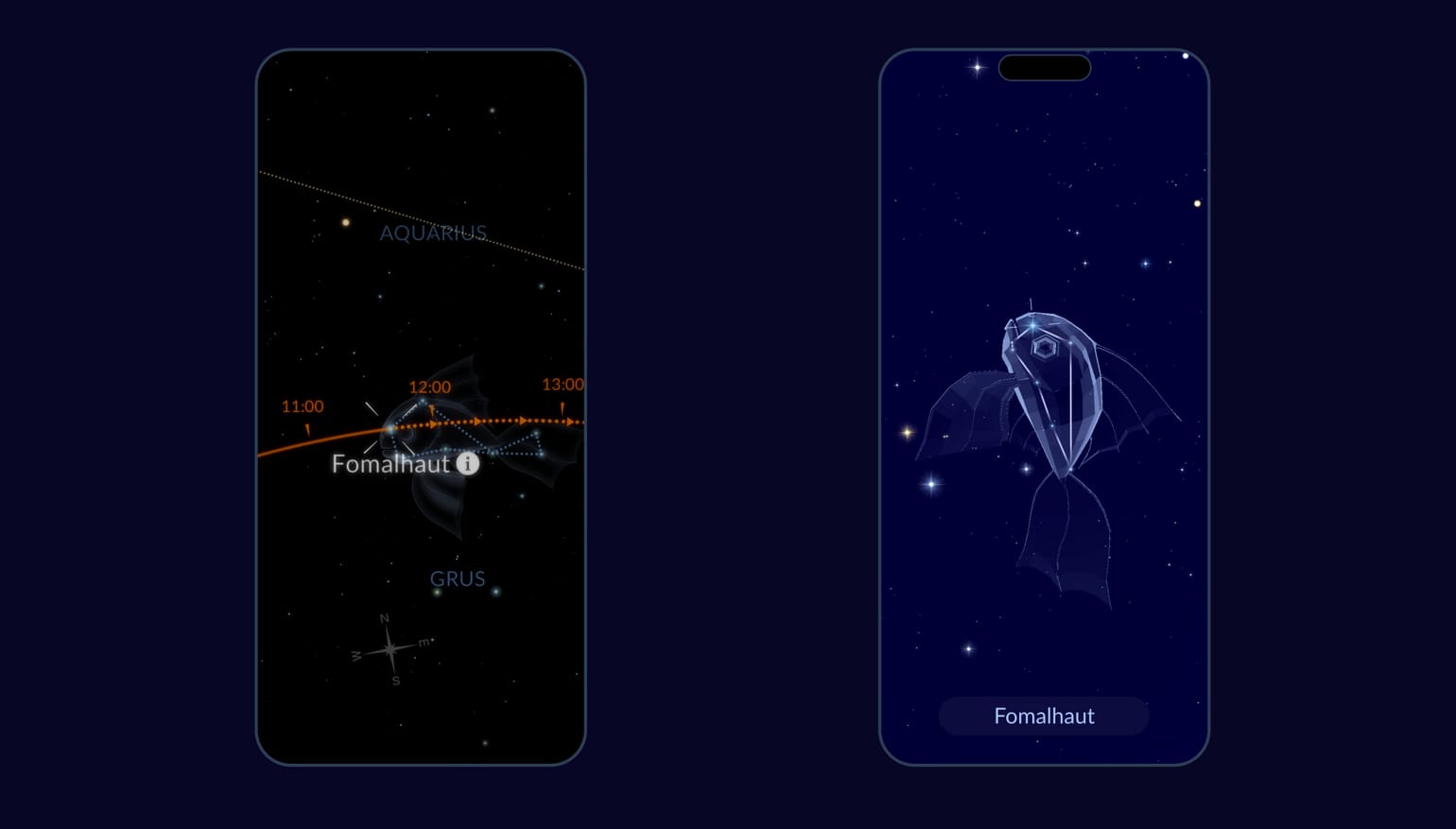Bright Stars & Constellations In the October Night Sky
The October night sky is full of wonders, and we'll help you discover the best of them with this handy stargazing guide! While we’ll focus only on some of the brightest stars and constellations, don’t forget – there’s so much more to discover every night. Use the Visible Tonight feature (the one with the telescope icon) in the Sky Tonight app to see exactly what’s above you, including stars, planets, and even deep-sky objects. Now, let’s dive into what stars and constellations you can spot in both hemispheres this October.
Contents
- October constellations
- Asterisms in October
- Bright stars to spot in October
- How to find these stars in the October night sky?
- October stargazing: bottom line
October constellations
In the northern October sky, you’ll find the constellations Aquarius, Grus, Lacerta, Octans, Pegasus, and Piscis Austrinus. And, of course, circumpolar constellations like Ursa Major and Cassiopeia are always visible – they never sink below the horizon.
Down in the Southern Hemisphere, Aquarius, Piscis Austrinus, Grus, and Octans light up the sky. The southern circumpolar constellations such as Crux and Carina are also in sight.

Asterisms in October
The Great Square of Pegasus
- Constellation: Pegasus
- Where to see: both hemispheres
Pegasus is one of the most recognizable constellations this month, thanks to its prominent asterism: the Great Square of Pegasus. Formed by four bright stars – Scheat, Markab, Algenib, and Alpheratz – it looks like a large, tilted square. This square is about 16° across (or about one and a half fists' width if held at arm's length). Pegasus lies just north of the celestial equator, which is why this constellation, together with the Great Square, is visible from almost every part of the world. The only place where it never rises is Antarctica.

The Water Jar
- Constellation: Aquarius
- Where to see: both hemispheres
Just south of Pegasus lies Aquarius, where you can spot a distinctive star pattern known as the Water Jar. This Y-shaped asterism is made up of Eta, Zeta, Pi, and Gamma Aquarii.

The Teapot
- Constellation: Sagittarius
- Where to see: both hemispheres
Be sure to spot the famous Teapot asterism in Sagittarius. The stars Kaus Media, Kaus Australis, Ascella, and Phi Sagittarii create the pot's body, while Kaus Borealis marks the lid. The tip of the spout is represented by Alnasl, and the handle is formed by Nunki and Tau Sagittarii. Under a dark sky, you might even see the Milky Way's “steam” rising from the spout.

The Summer Triangle
- Constellations: Lyra, Cygnus, Aquila
- Where to see: Northern Hemisphere
Though summer in the Northern Hemisphere is fading, you can still catch a glimpse of the Summer Triangle at sunset. It’s formed by Vega in Lyra, Deneb in Cygnus, and Altair in Aquila. In the Southern Hemisphere, the Summer Triangle is harder to see and appears upside down.

Bright stars to spot in October
Fomalhaut
- Constellation: Piscis Austrinus
- Where to see: both hemispheres
This October, be sure to search for Fomalhaut, a white star located only 25 light-years from Earth. In the Northern Hemisphere, it's known as the “Autumn Star” because it's only visible there in autumn. It’s the 18th brightest star in the sky with a magnitude of 1.16 and the only bright star in the constellation Piscis Austrinus. Fomalhaut is actually part of a triple star system, though its companions are too faint to see with the naked eye.
Arcturus
- Constellation: Boötes
- Where to see: both hemispheres
Arcturus, in the constellation Boötes, is a bright orange-red giant star, easily spotted in the northwest sky during October evenings. It is the 4th brightest star in the entire sky and is visible in both hemispheres.
How well do you know bright stars and where they are located? Test your knowledge with our star identification quiz!

Capella
- Constellation: Auriga
- Where to see: both hemispheres
You can find Capella rising in the early evening. It is part of the constellation Auriga and is the 6th brightest star in the night sky.
Aldebaran
- Constellation: Taurus
- Where to see: both hemispheres
In October, you can also see the red-giant star Aldebaran, the 14th brightest star in the sky, marking the eye of Taurus. Fun fact: in one of the indigenous languages of Mexico, the lunar month corresponding to October is called “Queeto yaao,” or “Aldebaran’s path.”
Sirius
- Constellation: Canis Major
- Where to see: both hemispheres
If you're up before dawn, you might be able to see Sirius blinking near the horizon. It is the brightest star in the sky. It sparkles particularly brightly in October, when it hangs low in the sky.
Not enough stars for you? Get the list of the brightest stars and their constellations in the form of a colorful infographic.

How to find these stars in the October night sky?
Finding the stars doesn't have to be complicated! You can do it the old-fashioned way by star-hopping, or make it easier by using an astronomy app like Star Walk 2 or Sky Tonight. Just type in the name of the star and the app will guide you to it – or point your device at the sky to identify objects in real time!

October stargazing: bottom line
Don’t miss out on the beauty of the October night sky! From Sirius twinkling at dawn to Fomalhaut glowing as the northern “Autumn Star,” there’s plenty to enjoy this month. Use the Star Walk 2 or Sky Tonight apps to guide your stargazing and explore even more celestial beauty with our article on October celestial events. Keep your eyes on the skies!
